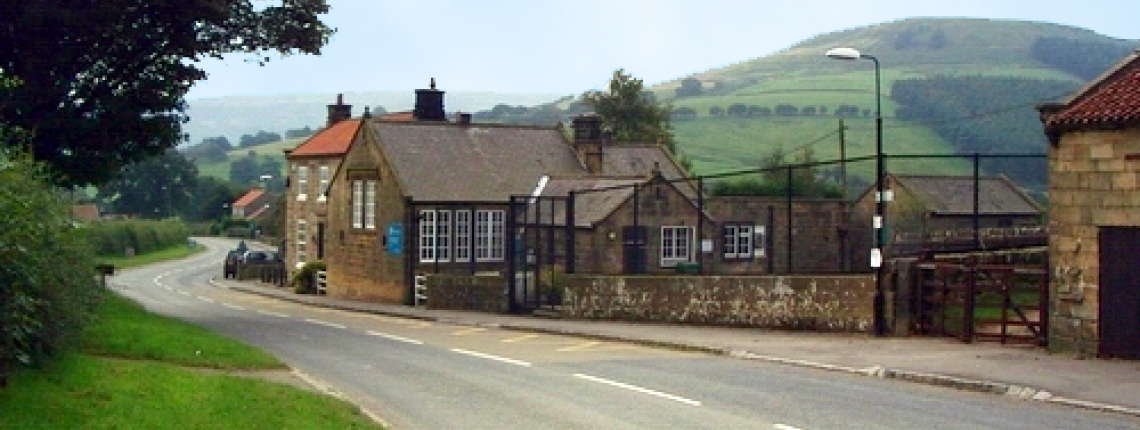A Short History
This section is provided by the Bilsdale Local History Group. New members are always welcome.
Bilsdale is the most westerly of the steep sided dales of the North York Moors. It stretches about ten miles from Clay Bank, on the Cleveland escarpment, south to Newgate Bank where the road climbs onto the tabular hills and heads for Helmsley. The final shape of the valley was sculpted out of the landscape by melt water during the last Ice Age about 15,000 years ago.
On the eastern side of the dale lies the ancient hamlet of Urra and two miles south is the village of Chop Gate. Further south is the hamlet of Fangdale Beck. The dale has two churches, St Hilda's Church serves the northern half of the dale and St John's Church serves the southern half. There are former Wesleyan chapels in Fangdale Beck and Chop Gate. The Friend's Meeting House is still standing near Laskill.
Evidence of early man can be found on the moors on either side of the dale. In addition to numerous tumili, a line of Bonze Age earthworks skirts the rim of Urra Moor and an impressive stone circle known as the Bride Stones stands on a prominent ridge near Tripsdale. The remains of a Celtic field system are found on the moors to the west. But it was the later waves of invading Anglo-Saxons and Vikings which left the dale its legacy of place names. The name Bilsdale is derived from the old Norse personal name "Bildr" and means "Bildr's valley".
In the 11th century William the Conquerer is reputed to have been lost in Bilsdale when returning from harrying rebels in the Coatham marshes. It was Norman Lord, Walter L'Espec who owned Bilsdale in the 12th century, who generously gave land to the Augustinians of Kirkham in the north of the dale and to the Cistercians of Rievaulx in the south. These two monastaries had a major impact on the life of the dale and its appearance, until the dissolution of the monasteries in 1538. Ownership then passed to the Earls of Rutland and subsequently to the Duke of Buckingham. The Duke died in1687 and his trustees sold the estate in 1695 to the Duncombe family whose heirs later became the Earls of Feversham.
It was the second Duke of Buckingham who established the Bilsdale Hunt in 1657, which claims to be the oldest in England. The hunt has close associations with the Sun Inn, one of the two inns in the dale. The old Sun Inn, a thatched cruck framed house (circa 1550) stands opposite the present day inn. The other inn, now the Buck Hotel, was the traditional venue for Bilsdale Agricultural Society's annual show. Both of the Inns host cricket teams.
There is evidence of iron working in the dale in medieval times. Itinerant smiths would practice the "mysteries" of smelting and iron working. Generally the ironstone deposits are of poor quality but a famous plough maker, John Wood, after studying the craft in other places. set up a foundry in Fangdale Beck in the late 19th century. Jet was also mined extensively in the latter half of the 19th century and the jet shale tips still scar the hillsides today. Jet, a fossilised wood, was fashioned into jewellery and became popular after Queen Victoria wore it as a sign of mourning on the death of Prince Albert in 1861. The alum industry left a major scar on Cartlton Bank, until the area was reclaimed in the 1990's. However, farming was always the main occupation in the past with the emphasis being on the traditional occupation of sheep rearing with the hardy Swaledale sheep grazing on the moorland sheep strays. 
Bilsdale's first school was recorded in 1781 in Chop Gate and Fangdale Beck school dates from 1814. The two schools flourished well into the 20th century but only the Chop Gate school remains today. Bilsdale Silver Band was founded in the mid 19th century and is still active. It is highly regarded and in great demand to perform at local functions. Bilsdale has a fascinating history but it has moved with the times and has a vibrant and active community participating in many local activities.
More information about the social and economic history of Bilsdale is set out in "Bygone Bilsdale", published by the Bilsdale Local History Group, price £5.95 inc p&p. Topics discussed include:
- Rievaulx and Carlton watercourses constructed by Joseph Foord
- Bilsdale Railway
- Ownership of Bilsdale
- Geology of Bilsdale
- Inkerman Friendly Society
- Sun Inn & Spout House, The Buck Inn,
- Alum, Iron smelting, and Jet mining
- St Hilda's and St John's churches, Chop Gate and Fangdale Beck chapels, Friends Meeting House
- Monks in Bilsdale, and the impact of Rievaulx Abbey
- William Ainsley, former landlord of the Sun Inn
- Surveys of Bilsdale since 1637 and census information
An exhibition celebrating the history of Bilsdale, "Bygones of Bilsdale" was held in St Hilda's Church in 2010.
If you are carrying out any research into Bilsdale places or people, please let us know. New members are always welcome at the Bilsdale Local History Group meetings which take place at the Buck Inn; or you can become a corresponding member and receive the monthly newsletter. web notes
There is a lot more information to include on this web site. If you would like to help, please let us know.





